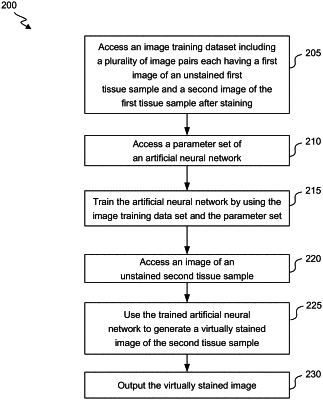| CPC G06T 7/0014 (2013.01) [G06N 3/08 (2013.01); G06N 20/00 (2019.01); G06T 3/0075 (2013.01); G06T 3/40 (2013.01); G06T 2207/10036 (2013.01); G06T 2207/20081 (2013.01); G06T 2207/20084 (2013.01)] | 20 Claims |

|
1. A computer-implemented method, comprising:
receiving an input image of a first biological sample, wherein the input image has a first spatial resolution and a plurality of spectral images, and wherein each spectral image of the plurality of spectral images includes data from a different wavelength band at a different spectral channel;
applying a trained artificial neural network to the input image, the trained artificial neural network trained using an image training data set including a plurality of image pairs, wherein each image pair of the plurality of image pairs includes a first image of a biological sample acquired when the biological sample is unstained, wherein the first image includes a first plurality of spectral images of the biological sample, and wherein each spectral image of the first plurality of spectral images includes data from a different wavelength band; and a second image of the biological sample acquired when the biological sample is stained;
generating an output image at a second spatial resolution, and wherein the output image includes a fewer number of spectral channels than the plurality of spectral images included in the input image; and
outputting the output image.
|